- Home
- Ann M. Martin
Maid Mary Anne Page 3
Maid Mary Anne Read online
Page 3
Dawn sighed and sat up. “No,” she said. “But I miss it a lot, these days.”
“Hey, it’s summer in Stoneybrook. Nice and hot. Not too far from the beach.”
Dawn smiled a little. “It’s warmer. But I wouldn’t call it hot.”
I laughed. “Guess what. Mrs. Towne invited me over tomorrow to talk about sewing. Isn’t that great?”
“It really is, Mary Anne,” said Dawn.
“Should I take some of my sewing? What would you do, Dawn? You know, you were exactly right about her being flattered. She even said so.”
“That’s great,” said Dawn. She reached over and turned the music off. “Come on and sit down.”
Still talking about Mrs. Towne, I made myself comfortable at the foot of Dawn’s bed. We talked until Sharon came up to tell us that, summer or no summer, we had to go to sleep.
“In California, it’s three hours earlier,” said Dawn.
“We’re not in California anymore,” said Sharon, grinning. “Come on, Mary Anne, Dawn.”
“Too bad we’re not in California, then, isn’t it, Dawn?” I said getting up. “Good night.”
“Good night,” said Dawn. As I left the room, I thought I heard her reach over and turn the Beach Boys back on, very softly.
I knocked on Mrs. Towne’s door at exactly four o’clock the next afternoon. To keep from being too nervous, I was trying to pretend I was knocking on the door of a new client for the BSC. Thinking of myself as Mary Anne Spier, baby-sitter, was easier than Mary Anne Spier, stranger-standing-at-the-door.
When Mrs. Towne didn’t answer right away, I thought she’d forgotten. Or maybe she’d changed her mind. I raised my hand. I looked down at my feet. Should I knock again? Or run away instead?
Fortunately, the door opened just then and Mrs. Towne took my upraised hand in hers as if it were perfectly normal to find someone standing at the door with her hand raised to shoulder height as if she were about to wave (or knock). She gave me a quick, formal handshake, saying as she did, “Mary Anne Spier?”
“Yes. Uh, Mrs. Towne?” Inside I groaned. What a dumb question. Who else would be answering Mrs. Towne’s door?
But Mrs. Towne didn’t seem to think it was dumb. She nodded, smiling, and stepped back for me to come in.
I don’t know what I’d expected Mrs. Towne to be like — maybe an apple-cheeked little old lady swathed in a big apron with her hair in a grandmotherly bun. Or maybe someone in a long, old-fashioned dress wearing one of those wrist pincushions stuck full of pins, peering nearsightedly (from all those hours spent sewing) at me through big glasses. Whatever it was, Mrs. Towne wasn’t quite what I’d pictured.
She was small, hardly any taller than I. But she wasn’t a storybook grandmotherly type with apple cheeks and a big apron. She had sharp, direct brown eyes and very short white hair that looked almost punk. Her skin was pale brown and smooth and soft, so that if it hadn’t been for her white hair, you wouldn’t have had any idea how old she might be.
No apron either. She was wearing jeans and a blue work shirt and tennis shoes.
Her house was more what I expected. Or at least, it was sort of familiar to me, because I could see as I stepped inside the door that it was an old farmhouse like ours, with low ceilings and stairs leading from the front hall, the same as in our house.
The familiarity made me feel less nervous. I began to relax.
“I’ve been looking forward to your visit,” said Mrs. Towne in a soft voice as she led the way down the hall. “I’ve set up tea on the back porch. It’s a nice view from there.”
We walked through a big, sunny, old-fashioned kitchen and out onto an even sunnier porch filled with plants of all kinds and sizes. At one end of the porch was a white table with two white chairs pulled up to it. On the table was a teapot, a bowl of sugar, a little pitcher of milk, a bowl of lemon slices, a plate of cookies, a saucer with a silver strainer not much bigger than a tablespoon, and two places set with cups and saucers, small plates, and teaspoons on top of neatly folded napkins.
“I had just taken the kettle off when you knocked,” explained Mrs. Towne, motioning me to one of the chairs. “I poured the hot water into the teapot before I answered the door, so the tea should be just about right. Do you like tea?”
Logan, who is from the South, drinks iced tea all the time, and Dawn drinks hot herb tea in the winter, but I’d never really thought about it. I nodded anyway.
“Oh, good,” said Mrs. Towne. She put a little silver strainer on top of my cup and poured the tea into it, then did the same with her cup. She set the strainer, which had loose tea leaves in it, on a separate plate. “This is chamomile tea. I made it from my own chamomile flowers.”
Fortunately, I’d heard of chamomile tea. It was one of the teas Dawn drank.
Mrs. Towne said, “Sugar? Milk or lemon?”
I put two teaspoons of sugar in the tea (something Dawn never would have done) and took a sugar cookie from the plate when Mrs. Towne offered it.
The tea was very hot, but it was good. I sipped it slowly, looking around the porch. I’d half expected to see samples of Mrs. Towne’s work everywhere, but the sun porch didn’t have room for anything, not even more plants.
“The way the porch is designed,” said Mrs. Towne, following my thoughts, “I’m able to use it as a sort of greenhouse for starting seedlings, even in the winter. The windows are all around, you see, and they slide open in the summer to let the warm air in through the screens. In the winter, they slide shut and I put up storm windows and open the heating vent. That way I have sun and warmth all year round.”
“That’s great,” I said, reminded again of Dawn. Would she think having a sun porch was almost as good as being in California? Somehow I didn’t think so.
“Have you been sewing long?” asked Mrs. Towne.
“I’ve always liked it,” I said, “but it wasn’t until recently that I really started to get interested in it.” (I decided not to mention the slight problem I’d had with home ec class.)
“My grandmother taught me how to sew,” said Mrs. Towne. “I was just a little girl. She could hand stitch a hem as fine as any sewing machine I’ve ever seen. She took in sewing for a living, and although we never had much money, I was always the best-dressed girl in school.”
“She made all your clothes by hand?” I asked incredulously.
“Lord, yes.” Mrs. Towne laughed. “We all grew up sewing. We’d sit at night and talk and sew, when there weren’t other chores to do, of course. It was wonderful.”
It sounded hard to me. And what if Mrs. Towne looked down on people who used sewing machines? I said, cautiously, “I’m just learning to embroider. I’ve read about French hand sewing. And I’d like to learn smocking, and more about sewing, too. But I’ve done most of my sewing on a machine.”
“Well, I don’t blame you!” said Mrs. Towne. “Times have changed. Sewing machines are great labor-saving devices. Although you still have to do some things by hand.”
“I know,” I said, relieved. I put down my empty cup.
“More tea?”
“Not right now, thank you,” I said. I suddenly realized that the teapot was wearing a little quilted coat.
“Did you make that?” I asked.
“The tea cozy? Yes, I did. It’s very old, almost as old as I am. It was one of my first quilting efforts, with my grandmother. Two layers of flannel — one of my father’s old flannel shirts, with cotton batting in between. It helps the tea stay warm inside the pot.”
“Like insulation,” I said.
“Exactly,” said Mrs. Towne. She put her own teacup down and stood up. “Why don’t I show you where I work and some of the other things I’ve done?”
“I’d love that,” I said truthfully. Now that I felt comfortable with Mrs. Towne, I could hardly wait to see her work.
I followed Mrs. Towne back out to the hall. She opened a door. “This is the guest room,” she said. “And this …”
“You ma
de that,” I said. Spread across the bed was the most beautiful quilt I had ever seen.
“The pattern is called Log Cabin. It’s an Amish pattern. The center of each of the squares is red because that symbolizes the hearth of the cabin: fire and warmth and where the meals are cooked.”
“It’s beautiful,” I said. I walked over to the bed. “May I touch it?”
“Lord, yes! It won’t break.”
I bent over and ran my hand over the quilted surface. The detail of the quilting — the stitching that sewed the front of the blanket to the back of the blanket — was intricate and precise.
Looking up the bed, I realized that the pillows were edged with the most delicate embroidery, white thread against the white cotton. “That, too?” I asked.
She nodded, smiling.
Mrs. Towne’s handiwork was evident in almost every room of the house: a footstool with a tapestry design worked into the top, the invisible hem on the fluted edge of a curtain — and a quilt in every room, either hanging on a wall, or spread across a bed.
Then we went into a large room on the front corner of the house. From the windows I could see the road and down the hill to the Stones’ farm.
“This is my workroom,” said Mrs. Towne. I stepped into the middle of the room and looked around in awe.
Although the room was big, you wouldn’t have realized it right away, because it was so full. To one side was a quilting frame, with what looked like a crazy quilt stretched across the top of it. Two dressmaker’s dummies, one large and one small, stood in a corner. A rack on the wall behind the dummies held, among other things, several pairs of scissors and shears in various sizes with straight and serrated edges, an assortment of embroidery hoops, a pattern-tracing wheel and a couple of tape measures, and various sewing rulers, curved and straight. A pattern, made of plain tissue paper, with various markings on it in pencil, was pinned to a piece of rose-printed material laid out on a large table. A sewing machine stood in a niche of its own by the window, with a sewing box on legs next to it. The top of the box was open and inside I could see, neatly arranged, dozens and dozens of spools of thread of all kinds and colors. A chest of drawers made up of many tiny drawers stood against one wall. Each drawer was labeled, and I realized that inside were various buttons, trims, pipings, beads, and all sorts of other sewing paraphernalia.
It was awesome.
“This is awesome,” I breathed, and then blushed, afraid Mrs. Towne would think I was weird.
But to my surprise she laughed. “That’s a nice way of putting it! My son, Cal — he lives in Missouri — calls it terrifying. But I know exactly where everything is. I ought to. I’ve been working in this room for years!”
“A pleater?” I asked. I pointed to a small machine with a row of needles on it. A piece of material was between the rollers behind the needles, waiting to be rolled through.
“Not everybody would know that!” laughed Mrs. Towne. “Do you have one?”
“No,” I said. “We just have the basic equipment. You know, a sewing machine, darning and crewel needles, some shears, and a pair of scissors.”
“Here, let me show you how it works.” Mrs. Towne sat down at the pleater and pulled a chair up next to her.
I was in sewing heaven.
Using the pleater wasn’t as hard as I thought it would be. After that, Mrs. Towne showed me some basic smocking and what she called “easy techniques for French hand sewing by machine.” It wasn’t that easy, but it was fascinating.
“You have a talent for this,” said Mrs. Towne as we were finishing up.
“Do you think … I mean, would it be possible for you to give me some lessons?” I asked.
To my surprise, Mrs. Towne said instantly, “What a wonderful idea, Mary Anne.”
“I’d pay you, of course,” I hurried on.
“When do you want to begin?” asked Mrs. Towne.
“I don’t know. What’s a good time for you? You have so much work. You must have a very busy schedule.”
“Don’t worry about that,” Mrs. Towne told me. “What about next Saturday afternoon? We could have a lesson and then tea.”
As Mrs. Towne walked me to the door, we worked out the details. I was so excited I practically levitated all the way home. I could hardly wait for next Saturday to come, to see more of Mrs. Towne’s work, and to begin to learn how to sew like she did.
I didn’t have to wait until Saturday to see Mrs. Towne, though. On Thursday afternoon I was baby-sitting for the younger Pike kids: Vanessa, Nicky, Claire, and Margo, and we went on another goat-visiting expedition.
I know, I know, it’s not the usual baby-sitting activity, but as it happened, Elvira Goat has been the star of a play written by Vanessa and performed by the Pike kids when she was being goat-sat by Dawn and me. So it was only natural that they’d want to visit their leading lady. Or maybe I mean their leading goat.
Of course, the visit was a huge success. Even chewing on the garbage du jour (that’s French for “of the day”) Elvira is terminally cute.
After the visit, as we were walking home talking about goats (what else?) a voice called to us and I looked up to see Mrs. Towne by one of the flower beds, holding a spade and wearing gloves and a baseball cap.
“Mary Anne?”
“Mrs. Towne! Hi! We were just on our way back from visiting the Stones’ farm.”
“And Elvira Goat,” called Claire importantly.
“Ah, yes. Mrs. Stone has told me about Elvira,” said Mrs. Towne.
“Do you like goats?” asked Claire.
“I do,” said Mrs. Towne. She and Claire exchanged smiles of mutual approval and then Mrs. Towne said, “Would you like to come in for a little while?”
I hesitated. I thought Mrs. Towne’s house was possibly the most wonderful place on earth, but I wasn’t sure what the Pikes would make of it.
As it turned out, I needn’t have worried. They seemed as fascinated as I had been. When Vanessa saw the Log Cabin quilt and heard the story of its pattern, she narrowed her eyes and studied it thoughtfully. Vanessa’s career plans (she’s nine) are to be a poet. I could see that the idea for a poem was germinating in her mind.
Nicky was more direct. “Cool,” he said to Mrs. Towne. “Are there more?” He plied her with questions about every quilt. His favorite, not surprisingly, was a finished crazy quilt displayed on the living room wall.
But to my amazement, the workroom enthralled them almost as much as it had me. I had noticed the children’s clothes patterns on my first visit, but I hadn’t looked closely at them. Vanessa, however, did, and was instantly in love with the picture smocking that decorated some of them, including scenes from fairy tales. Soon she was pointing out the various characters on a series of pillows Mrs. Towne was making, explaining them to Margo as if she had made them herself. Meanwhile, Nicky and Claire had gravitated to the quilting frame. Nicky bent over to look under it. “It’s just sitting on sawhorses,” he said.
“That’s right. The frame is used to stretch the top of the quilt out so you can sew the middle and the bottom to it. That’s the part that is called quilting — putting the three pieces together. This frame is a homemade frame. You can buy them, of course, but there’s no need to. My husband made that one for me.” For a moment, the bright, friendly look left Mrs. Towne’s face and she seemed sad, but Nicky’s next question brought it back.
“Do you have to know special stuff to make quilts?”
“No. At least I don’t think so. You can buy patterns for most of them. But even with patterns, you have to plan very carefully…. You know, a lot of these patterns are Amish patterns, which is why they are so abstract. The Amish aren’t allowed to show figures or any kind of realism in their quilting.”
“Cool,” said Nicky again. He reached out and gave the quilt a friendly pat.
And that gave me an idea.
We left soon after — the Pikes had to get home. I didn’t say anything about my idea then. I wanted to think it over a little
, and make sure it was as brilliant as I thought it was.
But I was pretty sure that it might possibly be one of those truly great, Kristy-caliber ideas. And if it was, I could hardly wait to tell my friends in the Baby-sitters Club.
Asking Mrs. Towne for sewing lessons was supposed to be the hard part. After that, I wasn’t going to be nervous at all. At least, that’s what I thought. But by Saturday afternoon after lunch, I was nervous all over again.
I wasn’t worried about seeing Mrs. Towne. I was looking forward to that. I could hardly wait to begin my sewing lessons.
But I couldn’t make up my mind about what to take. At one o’clock I was ransacking my sewing box. Thread? Should I take thread? If so, what kind? How much? What color? And what about scissors? Mrs. Towne had plenty of scissors and shears, but maybe she didn’t like for people to use her sewing equipment. Embroidery hoops? Samples of my own work?
Finally I settled on some black thread, some white thread, a paper of needles, a pair of scissors and a pair of shears, and a thimble. Then I looked at the clock, and said (just like the White Rabbit in Alice in Wonderland) “I’m late, I’m late, I’m late!”
I biked at top speed all the way to Mrs. Towne’s house. I wasn’t late, but I was panting when I rang her doorbell exactly at two o’clock.
Fortunately, Mrs. Towne didn’t come right away. I had time to catch my breath. Then I rang the doorbell again.
No one answered. I frowned. The doorbell was working. I could hear it. The screen door was shut but the front door behind it was open. I leaned forward and peered into the dim but now familiar hallway. I could see no sign of Mrs. Towne.
I rang the doorbell again.
But Mrs. Towne didn’t appear.
Of course! She was probably gardening and couldn’t even hear the doorbell. I put my makeshift sewing kit (it was an old canvas tote bag with a picture of a kitten on the front) on the porch, went down the stairs, and walked around to the back of the house.
The air was warm and the bees were making a drowsy buzzing sound among the holly-hocks and zinnias. But there was no sign of Mrs. Towne anywhere. To make sure, I walked back to the front porch from the other side of the house.

 Karen's Tea Party
Karen's Tea Party Kristy and the Snobs
Kristy and the Snobs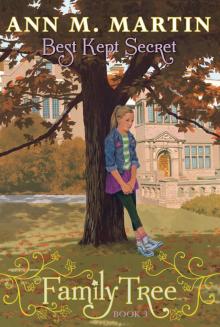 Best Kept Secret
Best Kept Secret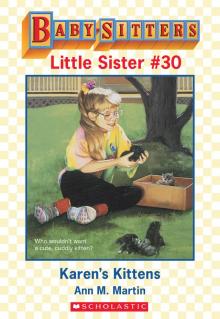 Karen's Kittens
Karen's Kittens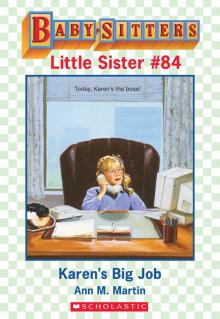 Karen's Big Job
Karen's Big Job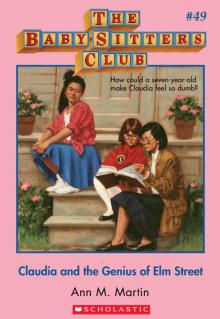 Claudia and the Genius of Elm Street
Claudia and the Genius of Elm Street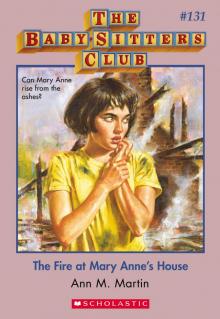 The Fire at Mary Anne's House
The Fire at Mary Anne's House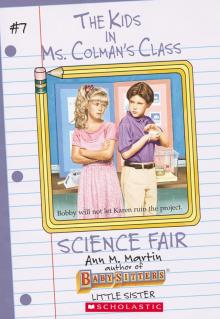 Science Fair
Science Fair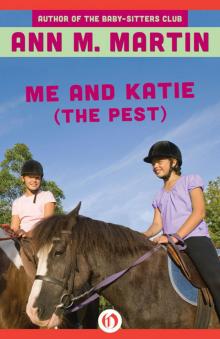 Me and Katie (The Pest)
Me and Katie (The Pest)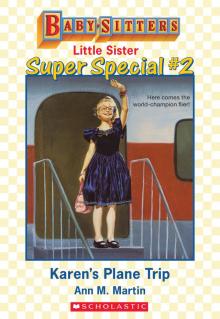 Karen's Plane Trip
Karen's Plane Trip Jessi's Wish
Jessi's Wish Dawn and Too Many Sitters
Dawn and Too Many Sitters Jessi and the Jewel Thieves
Jessi and the Jewel Thieves Eleven Kids, One Summer
Eleven Kids, One Summer Karen's Goldfish
Karen's Goldfish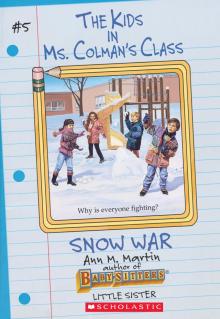 Snow War
Snow War Abby and the Secret Society
Abby and the Secret Society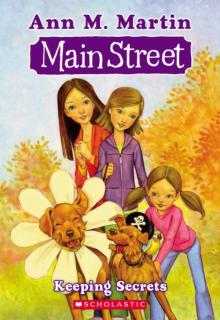 Keeping Secrets
Keeping Secrets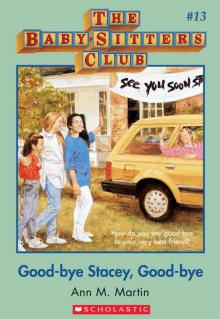 Good-Bye Stacey, Good-Bye
Good-Bye Stacey, Good-Bye Karen's Sleepover
Karen's Sleepover Claudia and the World's Cutest Baby
Claudia and the World's Cutest Baby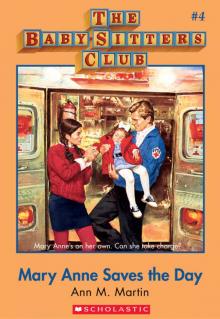 Mary Anne Saves the Day
Mary Anne Saves the Day Mallory and the Dream Horse
Mallory and the Dream Horse Kristy and the Mystery Train
Kristy and the Mystery Train Dawn's Family Feud
Dawn's Family Feud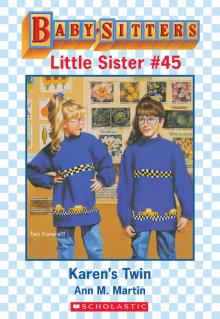 Karen's Twin
Karen's Twin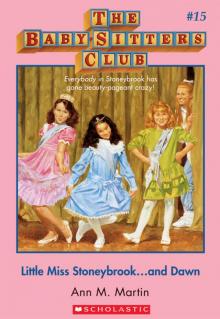 Little Miss Stoneybrook... And Dawn
Little Miss Stoneybrook... And Dawn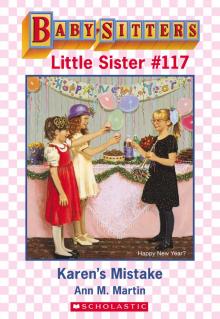 Karen's Mistake
Karen's Mistake Karen's Movie Star
Karen's Movie Star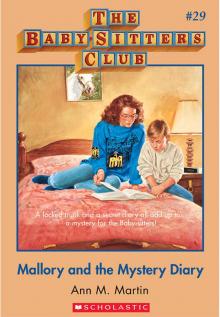 Mallory and the Mystery Diary
Mallory and the Mystery Diary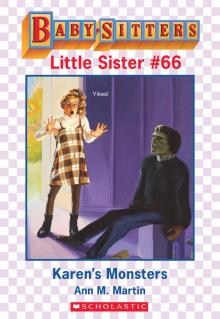 Karen's Monsters
Karen's Monsters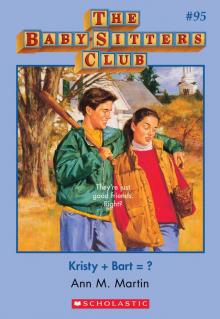 Kristy + Bart = ?
Kristy + Bart = ?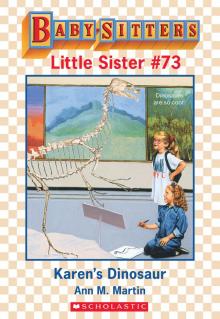 Karen's Dinosaur
Karen's Dinosaur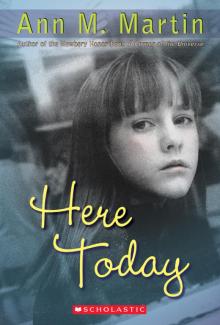 Here Today
Here Today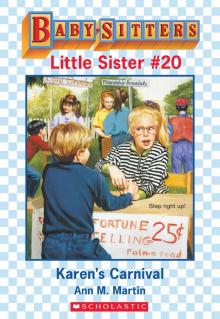 Karen's Carnival
Karen's Carnival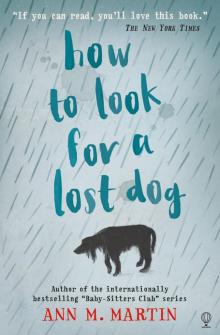 How to Look for a Lost Dog
How to Look for a Lost Dog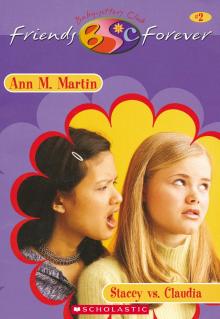 Stacey vs. Claudia
Stacey vs. Claudia Stacey's Ex-Boyfriend
Stacey's Ex-Boyfriend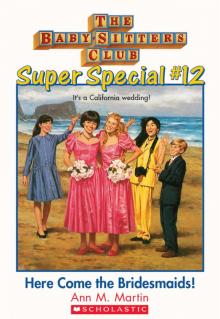 Here Come the Bridesmaids!
Here Come the Bridesmaids! Graduation Day
Graduation Day Kristy's Big News
Kristy's Big News Karen's School Surprise
Karen's School Surprise Kristy Thomas, Dog Trainer
Kristy Thomas, Dog Trainer Baby-Sitters' Christmas Chiller
Baby-Sitters' Christmas Chiller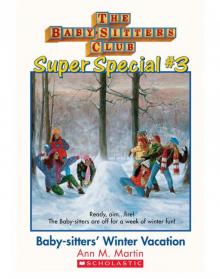 Baby-Sitters' Winter Vacation
Baby-Sitters' Winter Vacation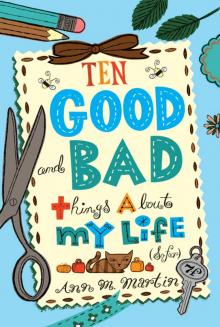 Ten Good and Bad Things About My Life
Ten Good and Bad Things About My Life Claudia and the Bad Joke
Claudia and the Bad Joke Mary Anne's Makeover
Mary Anne's Makeover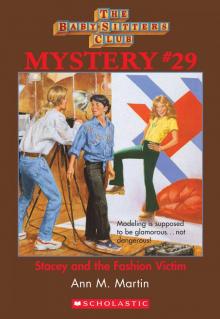 Stacey and the Fashion Victim
Stacey and the Fashion Victim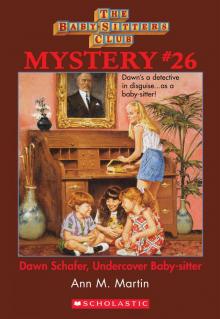 Dawn Schafer, Undercover Baby-Sitter
Dawn Schafer, Undercover Baby-Sitter Karen's Tuba
Karen's Tuba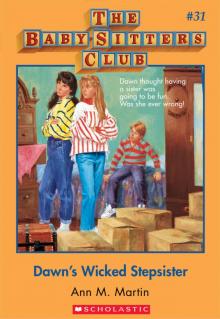 Dawn's Wicked Stepsister
Dawn's Wicked Stepsister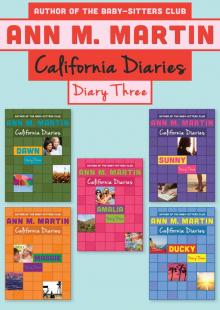 Diary Three: Dawn, Sunny, Maggie, Amalia, and Ducky
Diary Three: Dawn, Sunny, Maggie, Amalia, and Ducky Karen's Nanny
Karen's Nanny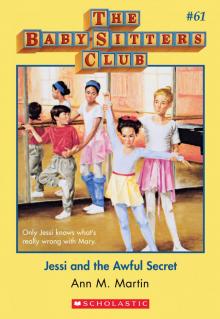 Jessi and the Awful Secret
Jessi and the Awful Secret Karen's New Year
Karen's New Year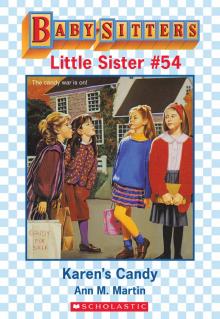 Karen's Candy
Karen's Candy Karen's President
Karen's President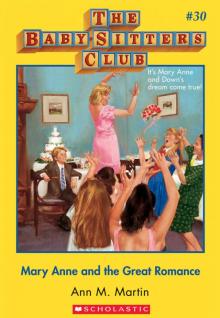 Mary Anne and the Great Romance
Mary Anne and the Great Romance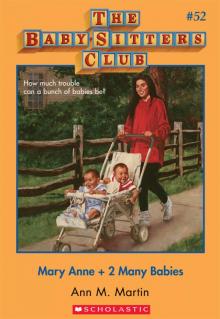 Mary Anne + 2 Many Babies
Mary Anne + 2 Many Babies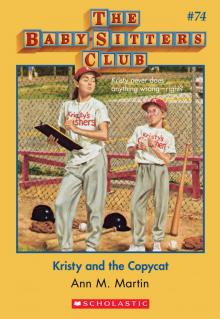 Kristy and the Copycat
Kristy and the Copycat Jessi and the Bad Baby-Sitter
Jessi and the Bad Baby-Sitter Claudia, Queen of the Seventh Grade
Claudia, Queen of the Seventh Grade Claudia and the Lighthouse Ghost
Claudia and the Lighthouse Ghost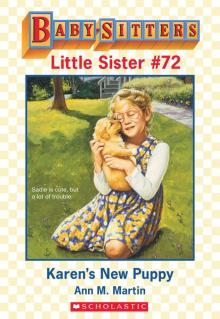 Karen's New Puppy
Karen's New Puppy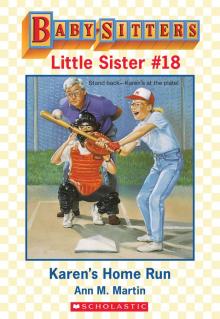 Karen's Home Run
Karen's Home Run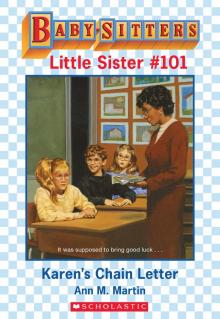 Karen's Chain Letter
Karen's Chain Letter Kristy in Charge
Kristy in Charge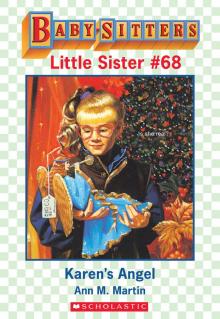 Karen's Angel
Karen's Angel Mary Anne and Too Many Boys
Mary Anne and Too Many Boys Karen's Big Fight
Karen's Big Fight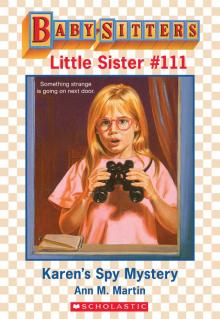 Karen's Spy Mystery
Karen's Spy Mystery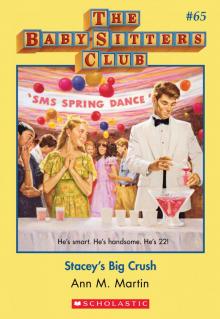 Stacey's Big Crush
Stacey's Big Crush Karen's School
Karen's School Claudia and the Terrible Truth
Claudia and the Terrible Truth Karen's Cowboy
Karen's Cowboy The Summer Before
The Summer Before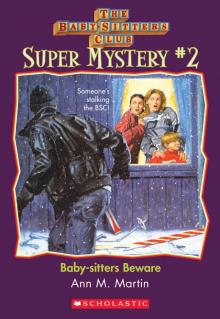 Beware, Dawn!
Beware, Dawn!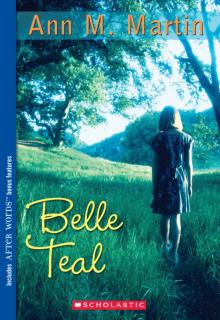 Belle Teale
Belle Teale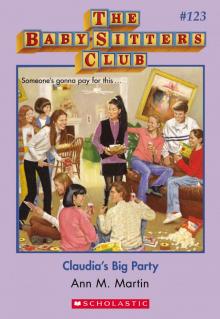 Claudia's Big Party
Claudia's Big Party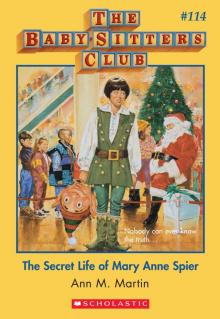 The Secret Life of Mary Anne Spier
The Secret Life of Mary Anne Spier Karen's Book
Karen's Book Teacher's Pet
Teacher's Pet Boy-Crazy Stacey
Boy-Crazy Stacey Claudia and the Disaster Date
Claudia and the Disaster Date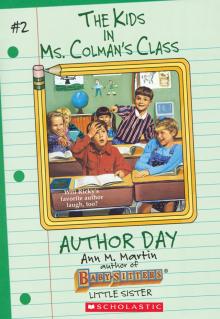 Author Day
Author Day Claudia and the Sad Good-Bye
Claudia and the Sad Good-Bye Kristy and the Worst Kid Ever
Kristy and the Worst Kid Ever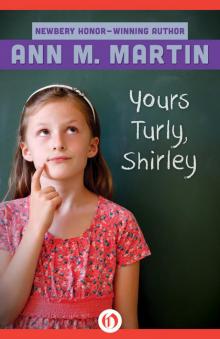 Yours Turly, Shirley
Yours Turly, Shirley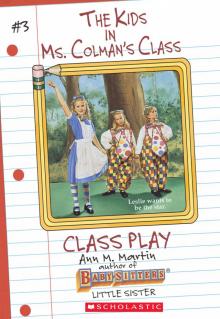 Class Play
Class Play Kristy and the Vampires
Kristy and the Vampires Kristy and the Cat Burglar
Kristy and the Cat Burglar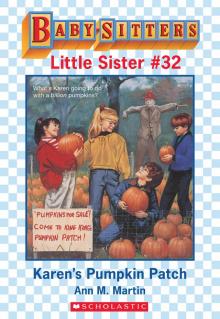 Karen's Pumpkin Patch
Karen's Pumpkin Patch Stacey and the Mystery at the Empty House
Stacey and the Mystery at the Empty House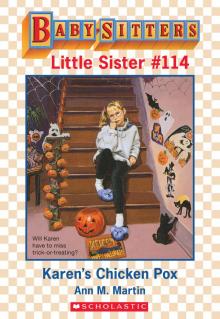 Karen's Chicken Pox
Karen's Chicken Pox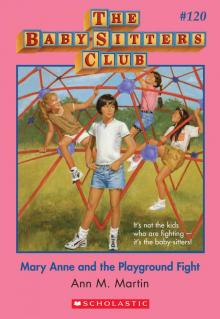 Mary Anne and the Playground Fight
Mary Anne and the Playground Fight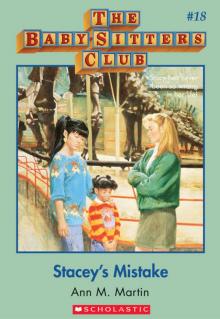 Stacey's Mistake
Stacey's Mistake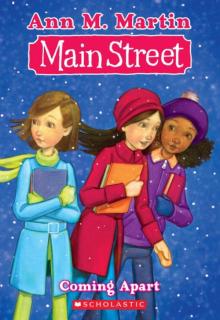 Coming Apart
Coming Apart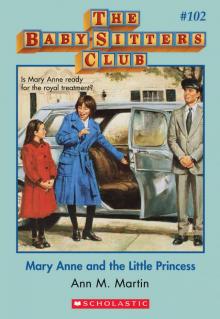 Mary Anne and the Little Princess
Mary Anne and the Little Princess Karen, Hannie and Nancy: The Three Musketeers
Karen, Hannie and Nancy: The Three Musketeers 'Tis the Season
'Tis the Season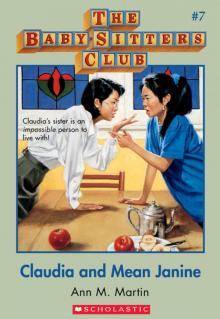 Claudia and Mean Janine
Claudia and Mean Janine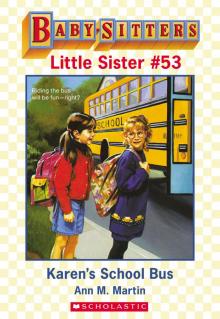 Karen's School Bus
Karen's School Bus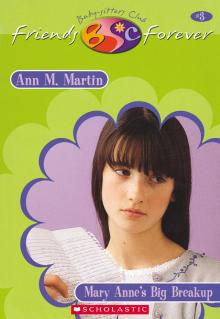 Mary Anne's Big Breakup
Mary Anne's Big Breakup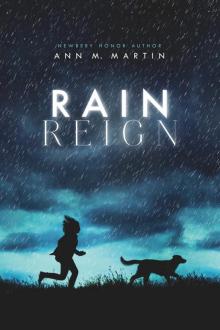 Rain Reign
Rain Reign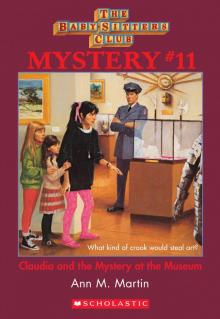 Claudia and the Mystery at the Museum
Claudia and the Mystery at the Museum Claudia and the Great Search
Claudia and the Great Search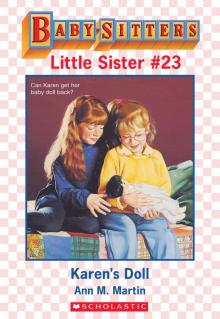 Karen's Doll
Karen's Doll Shannon's Story
Shannon's Story Sea City, Here We Come!
Sea City, Here We Come!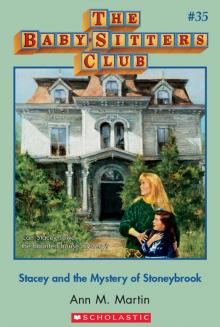 Stacey and the Mystery of Stoneybrook
Stacey and the Mystery of Stoneybrook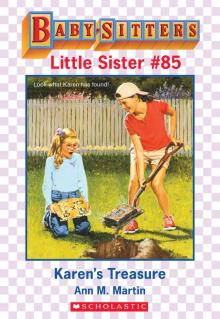 Karen's Treasure
Karen's Treasure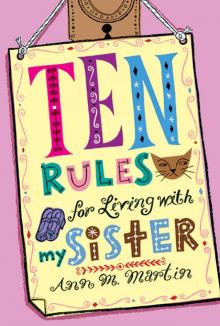 Ten Rules for Living With My Sister
Ten Rules for Living With My Sister With You and Without You
With You and Without You Baby-Sitters' Island Adventure
Baby-Sitters' Island Adventure Karen's Fishing Trip
Karen's Fishing Trip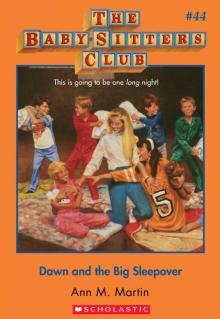 Dawn and the Big Sleepover
Dawn and the Big Sleepover New York, New York!
New York, New York!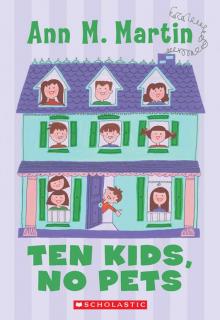 Ten Kids, No Pets
Ten Kids, No Pets Happy Holidays, Jessi
Happy Holidays, Jessi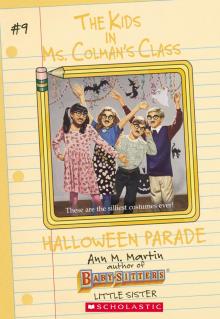 Halloween Parade
Halloween Parade Karen's New Holiday
Karen's New Holiday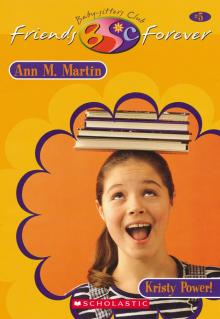 Kristy Power!
Kristy Power!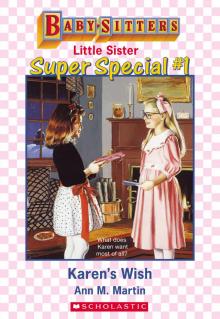 Karen's Wish
Karen's Wish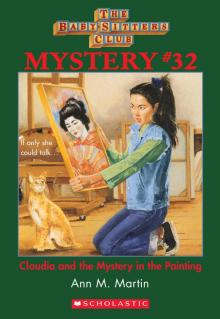 Claudia and the Mystery in the Painting
Claudia and the Mystery in the Painting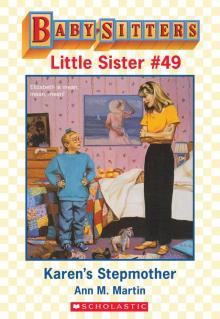 Karen's Stepmother
Karen's Stepmother Abby in Wonderland
Abby in Wonderland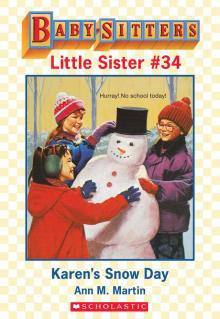 Karen's Snow Day
Karen's Snow Day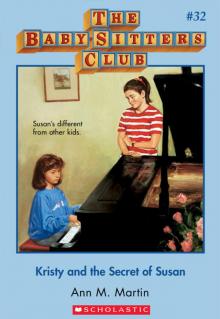 Kristy and the Secret of Susan
Kristy and the Secret of Susan Karen's Pony Camp
Karen's Pony Camp Karen's School Trip
Karen's School Trip Mary Anne to the Rescue
Mary Anne to the Rescue Karen's Unicorn
Karen's Unicorn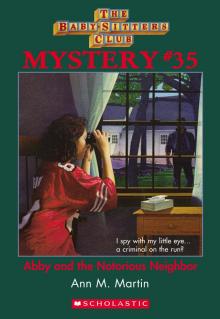 Abby and the Notorious Neighbor
Abby and the Notorious Neighbor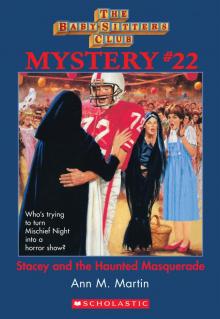 Stacey and the Haunted Masquerade
Stacey and the Haunted Masquerade Claudia Gets Her Guy
Claudia Gets Her Guy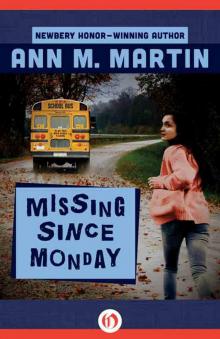 Missing Since Monday
Missing Since Monday Stacey's Choice
Stacey's Choice Stacey's Ex-Best Friend
Stacey's Ex-Best Friend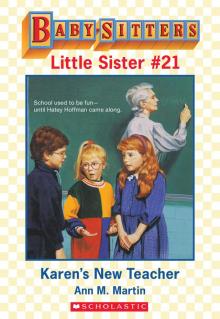 Karen's New Teacher
Karen's New Teacher Karen's Accident
Karen's Accident Karen's Lucky Penny
Karen's Lucky Penny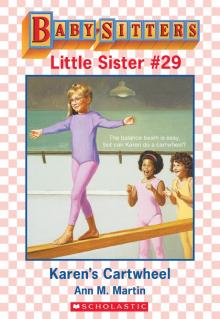 Karen's Cartwheel
Karen's Cartwheel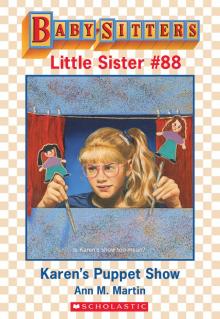 Karen's Puppet Show
Karen's Puppet Show Spelling Bee
Spelling Bee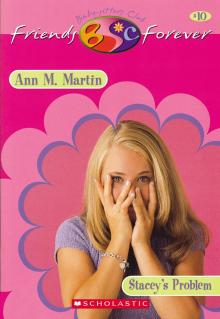 Stacey's Problem
Stacey's Problem Stacey and the Stolen Hearts
Stacey and the Stolen Hearts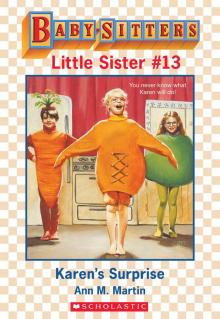 Karen's Surprise
Karen's Surprise Karen's Worst Day
Karen's Worst Day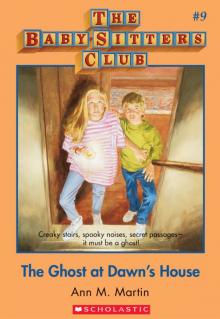 The Ghost at Dawn's House
The Ghost at Dawn's House Karen's Big Sister
Karen's Big Sister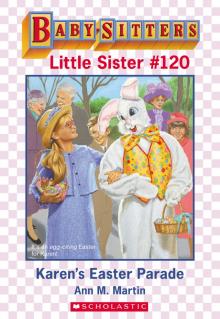 Karen's Easter Parade
Karen's Easter Parade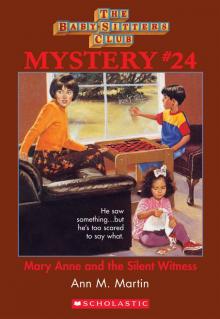 Mary Anne and the Silent Witness
Mary Anne and the Silent Witness Karen's Swim Meet
Karen's Swim Meet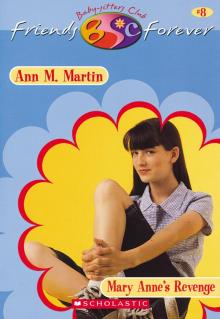 Mary Anne's Revenge
Mary Anne's Revenge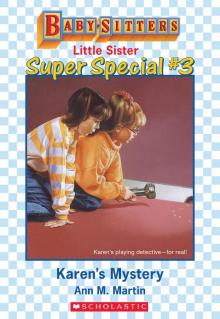 Karen's Mystery
Karen's Mystery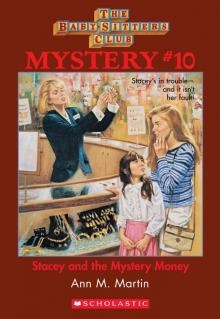 Stacey and the Mystery Money
Stacey and the Mystery Money Dawn and the Disappearing Dogs
Dawn and the Disappearing Dogs Karen's Christmas Tree
Karen's Christmas Tree Welcome to Camden Falls
Welcome to Camden Falls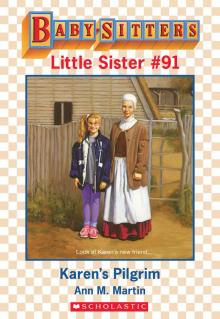 Karen's Pilgrim
Karen's Pilgrim Dawn and the Halloween Mystery
Dawn and the Halloween Mystery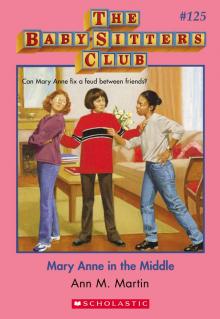 Mary Anne in the Middle
Mary Anne in the Middle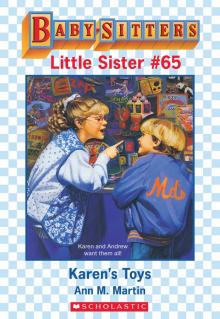 Karen's Toys
Karen's Toys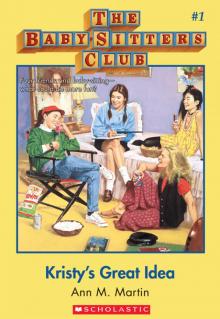 Kristy's Great Idea
Kristy's Great Idea Claudia and the Middle School Mystery
Claudia and the Middle School Mystery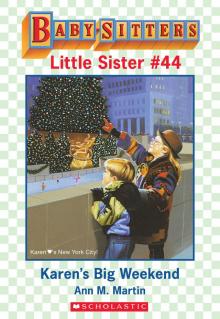 Karen's Big Weekend
Karen's Big Weekend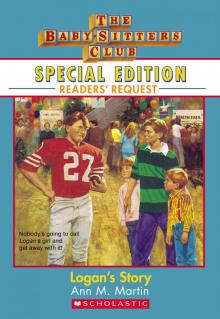 Logan's Story
Logan's Story Karen's Yo-Yo
Karen's Yo-Yo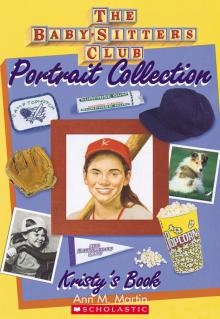 Kristy's Book
Kristy's Book Mallory and the Ghost Cat
Mallory and the Ghost Cat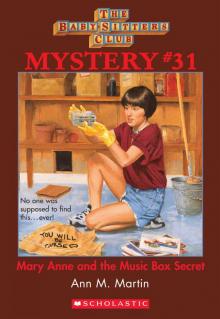 Mary Anne and the Music
Mary Anne and the Music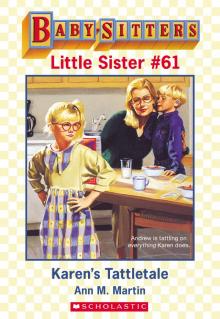 Karen's Tattletale
Karen's Tattletale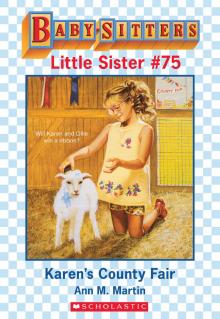 Karen's County Fair
Karen's County Fair Karen's Mermaid
Karen's Mermaid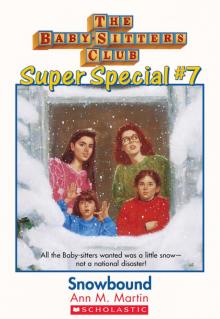 Snowbound
Snowbound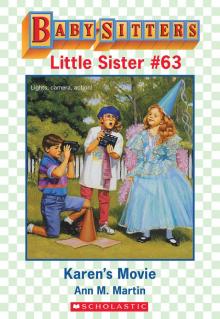 Karen's Movie
Karen's Movie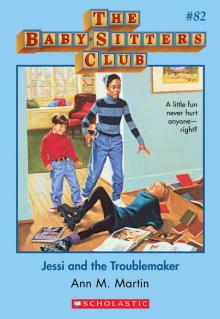 Jessi and the Troublemaker
Jessi and the Troublemaker Baby-Sitters at Shadow Lake
Baby-Sitters at Shadow Lake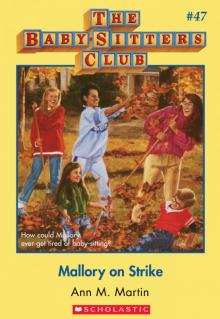 Mallory on Strike
Mallory on Strike Jessi's Baby-Sitter
Jessi's Baby-Sitter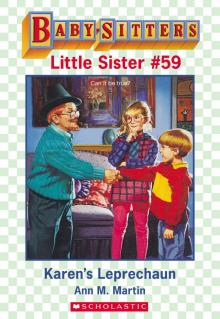 Karen's Leprechaun
Karen's Leprechaun Claudia and the Phantom Phone Calls
Claudia and the Phantom Phone Calls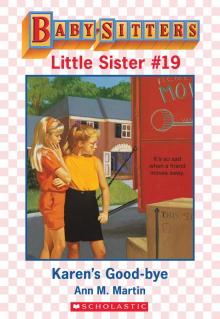 Karen's Good-Bye
Karen's Good-Bye Karen's Figure Eight
Karen's Figure Eight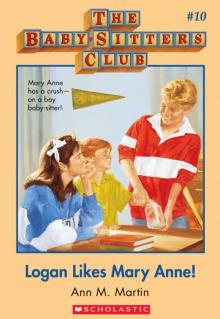 Logan Likes Mary Anne!
Logan Likes Mary Anne! Mary Anne and the Zoo Mystery
Mary Anne and the Zoo Mystery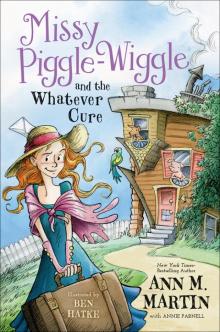 Missy Piggle-Wiggle and the Whatever Cure
Missy Piggle-Wiggle and the Whatever Cure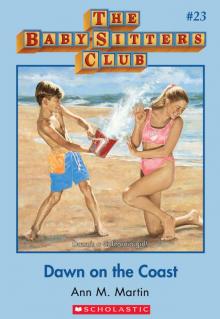 Dawn on the Coast
Dawn on the Coast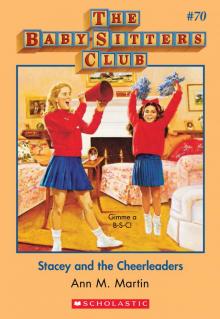 Stacey and the Cheerleaders
Stacey and the Cheerleaders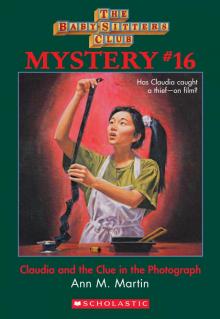 Claudia and the Clue in the Photograph
Claudia and the Clue in the Photograph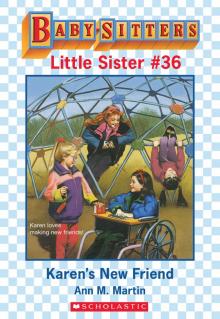 Karen's New Friend
Karen's New Friend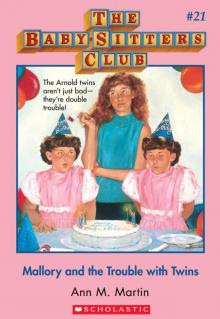 Mallory and the Trouble With Twins
Mallory and the Trouble With Twins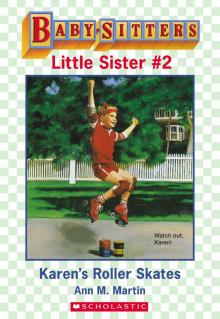 Karen's Roller Skates
Karen's Roller Skates Abby and the Best Kid Ever
Abby and the Best Kid Ever Poor Mallory!
Poor Mallory!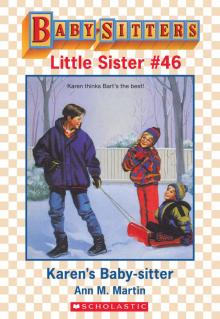 Karen's Witch
Karen's Witch Karen's Grandmothers
Karen's Grandmothers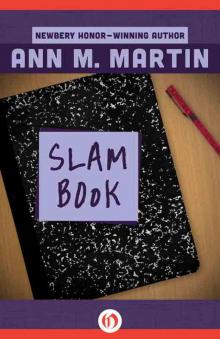 Slam Book
Slam Book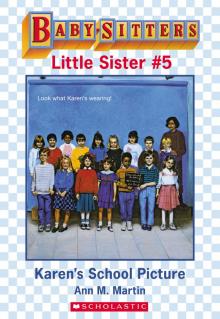 Karen's School Picture
Karen's School Picture Karen's Reindeer
Karen's Reindeer Kristy's Big Day
Kristy's Big Day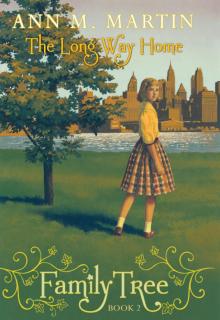 The Long Way Home
The Long Way Home Karen's Sleigh Ride
Karen's Sleigh Ride On Christmas Eve
On Christmas Eve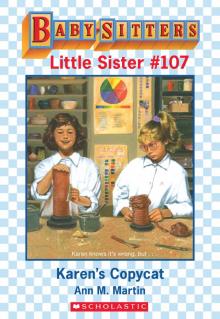 Karen's Copycat
Karen's Copycat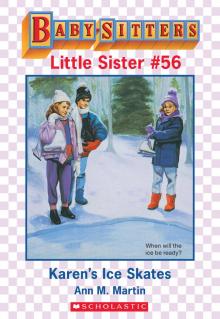 Karen's Ice Skates
Karen's Ice Skates Claudia and the Little Liar
Claudia and the Little Liar Abby the Bad Sport
Abby the Bad Sport The Baby-Sitters Club #5: Dawn and the Impossible Three
The Baby-Sitters Club #5: Dawn and the Impossible Three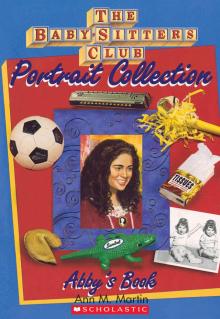 Abby's Book
Abby's Book Karen's Big Top
Karen's Big Top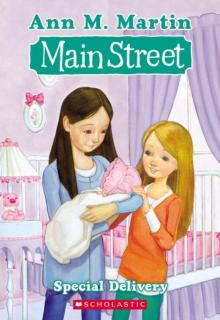 Main Street #8: Special Delivery
Main Street #8: Special Delivery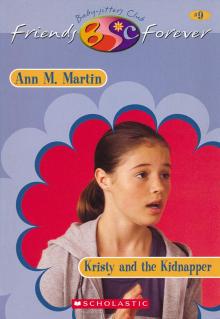 Kristy and the Kidnapper
Kristy and the Kidnapper Karen's Ski Trip
Karen's Ski Trip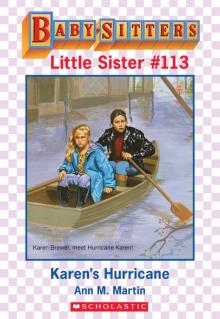 Karen's Hurricane
Karen's Hurricane Stacey and the Mystery at the Mall
Stacey and the Mystery at the Mall Jessi and the Superbrat
Jessi and the Superbrat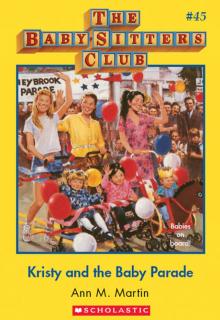 Kristy and the Baby Parade
Kristy and the Baby Parade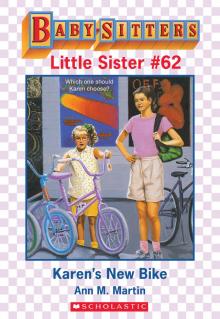 Karen's New Bike
Karen's New Bike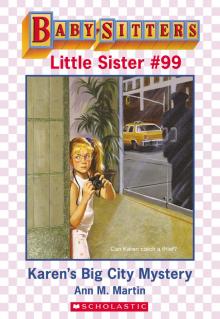 Karen's Big City Mystery
Karen's Big City Mystery Baby-Sitters' European Vacation
Baby-Sitters' European Vacation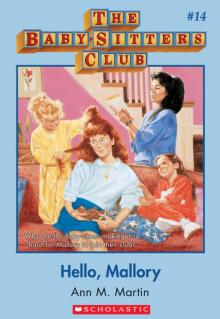 Hello, Mallory
Hello, Mallory Dawn's Big Date
Dawn's Big Date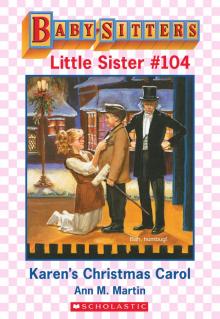 Karen's Christmas Carol
Karen's Christmas Carol Jessi's Horrible Prank
Jessi's Horrible Prank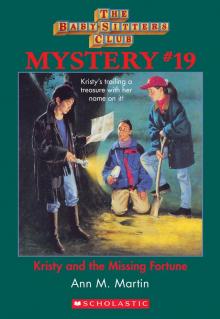 Kristy and the Missing Fortune
Kristy and the Missing Fortune Kristy and the Haunted Mansion
Kristy and the Haunted Mansion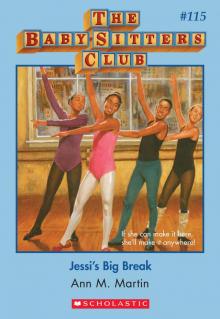 Jessi's Big Break
Jessi's Big Break Karen's Pony
Karen's Pony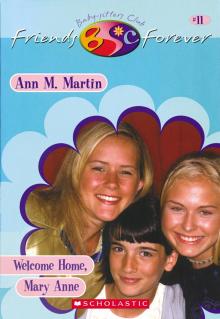 Welcome Home, Mary Anne
Welcome Home, Mary Anne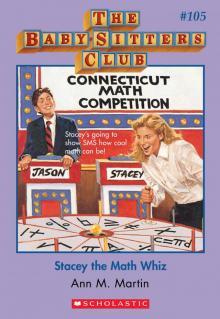 Stacey the Math Whiz
Stacey the Math Whiz September Surprises
September Surprises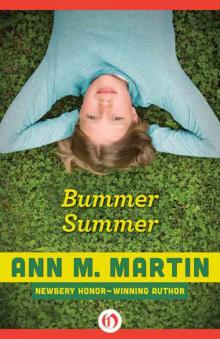 Bummer Summer
Bummer Summer Karen's Secret
Karen's Secret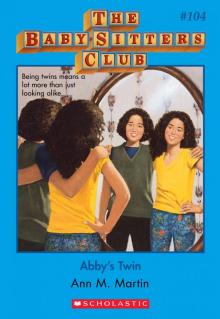 Abby's Twin
Abby's Twin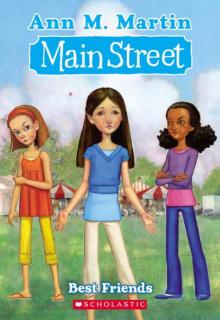 Main Street #4: Best Friends
Main Street #4: Best Friends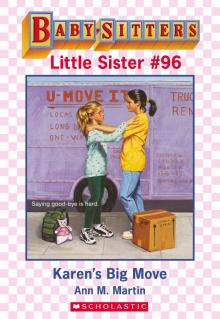 Karen's Big Move
Karen's Big Move Mary Anne Misses Logan
Mary Anne Misses Logan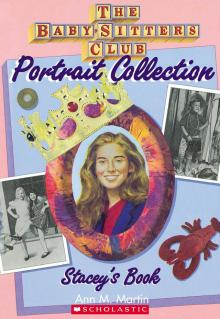 Stacey's Book
Stacey's Book Claudia and the Perfect Boy
Claudia and the Perfect Boy Holiday Time
Holiday Time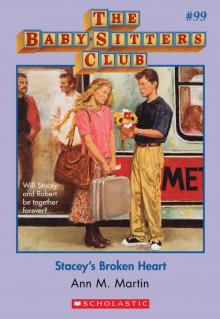 Stacey's Broken Heart
Stacey's Broken Heart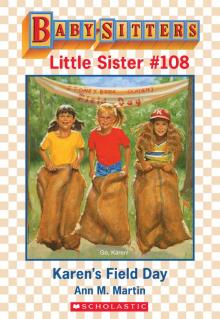 Karen's Field Day
Karen's Field Day Kristy's Worst Idea
Kristy's Worst Idea Dawn and the Older Boy
Dawn and the Older Boy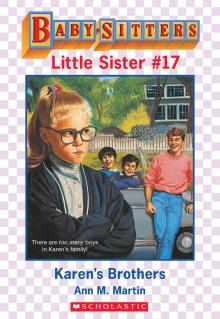 Karen's Brothers
Karen's Brothers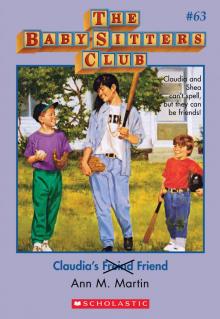 Claudia's Friend
Claudia's Friend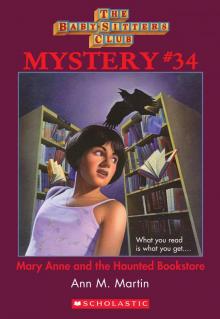 Mary Anne and the Haunted Bookstore
Mary Anne and the Haunted Bookstore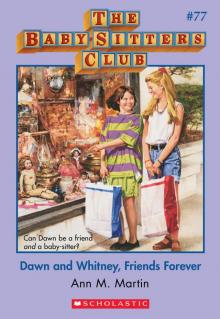 Dawn and Whitney, Friends Forever
Dawn and Whitney, Friends Forever Summer School
Summer School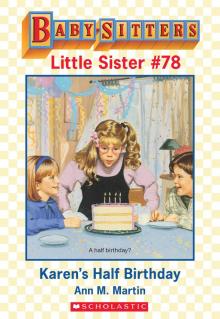 Karen's Birthday
Karen's Birthday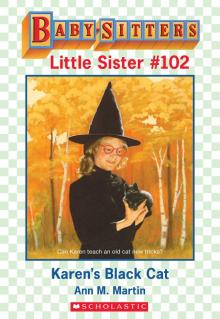 Karen's Black Cat
Karen's Black Cat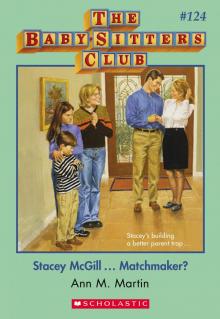 Stacey McGill... Matchmaker?
Stacey McGill... Matchmaker?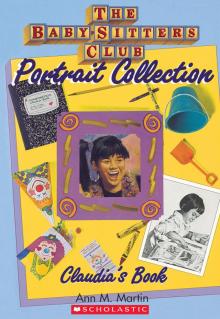 Claudia's Book
Claudia's Book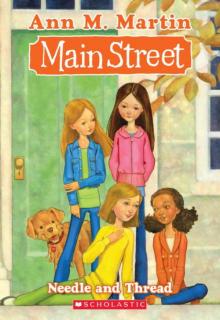 Main Street #2: Needle and Thread
Main Street #2: Needle and Thread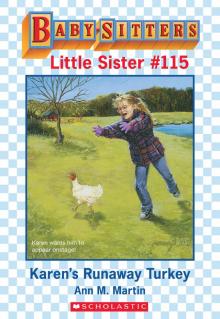 Karen's Runaway Turkey
Karen's Runaway Turkey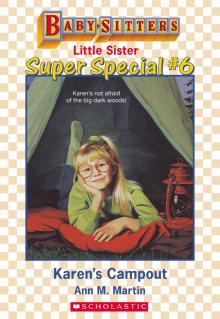 Karen's Campout
Karen's Campout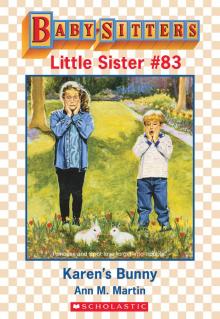 Karen's Bunny
Karen's Bunny Claudia and the New Girl
Claudia and the New Girl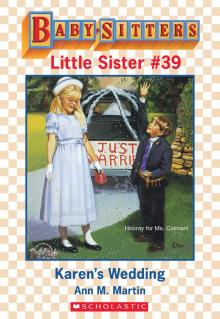 Karen's Wedding
Karen's Wedding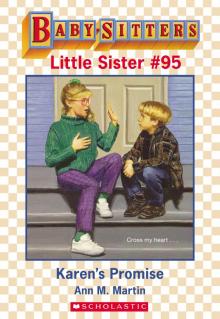 Karen's Promise
Karen's Promise Karen's Snow Princess
Karen's Snow Princess Claudia Kishi, Middle School Dropout
Claudia Kishi, Middle School Dropout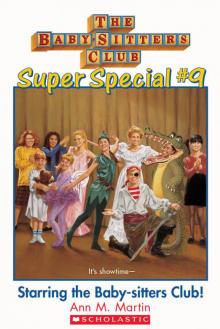 Starring the Baby-Sitters Club!
Starring the Baby-Sitters Club!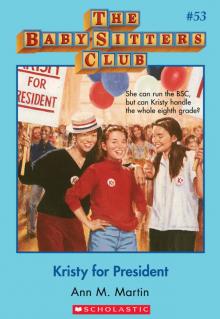 Kristy for President
Kristy for President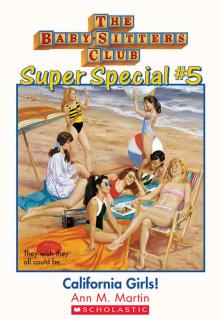 California Girls!
California Girls!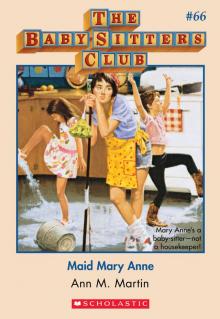 Maid Mary Anne
Maid Mary Anne Abby's Un-Valentine
Abby's Un-Valentine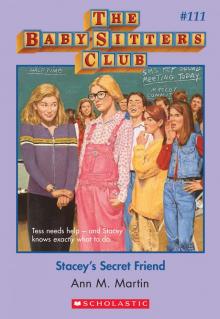 Stacey's Secret Friend
Stacey's Secret Friend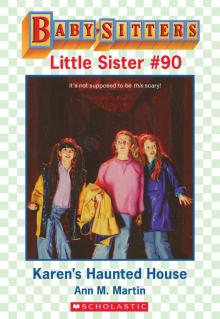 Karen's Haunted House
Karen's Haunted House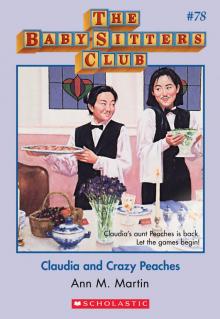 Claudia and Crazy Peaches
Claudia and Crazy Peaches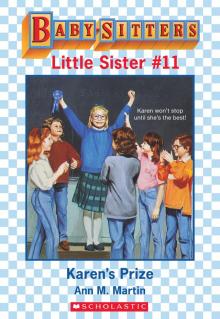 Karen's Prize
Karen's Prize Get Well Soon, Mallory!
Get Well Soon, Mallory!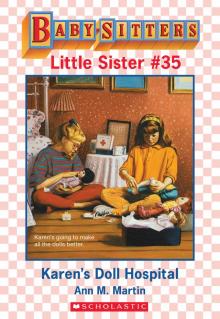 Karen's Doll Hospital
Karen's Doll Hospital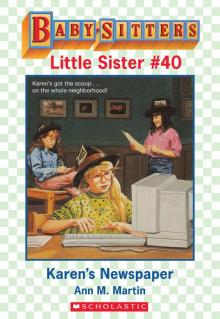 Karen's Newspaper
Karen's Newspaper Karen's Toothache
Karen's Toothache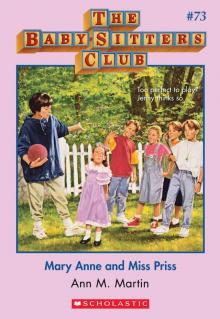 Mary Anne and Miss Priss
Mary Anne and Miss Priss Abby's Lucky Thirteen
Abby's Lucky Thirteen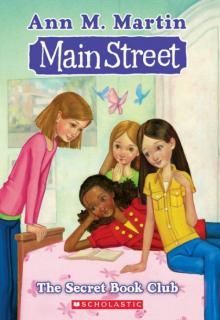 The Secret Book Club
The Secret Book Club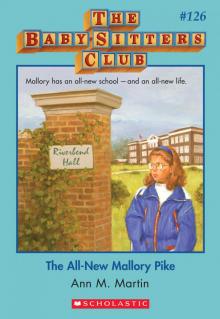 The All-New Mallory Pike
The All-New Mallory Pike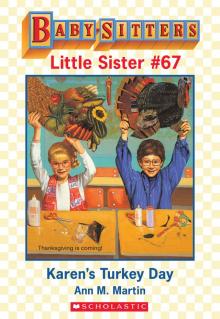 Karen's Turkey Day
Karen's Turkey Day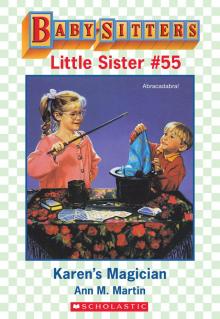 Karen's Magician
Karen's Magician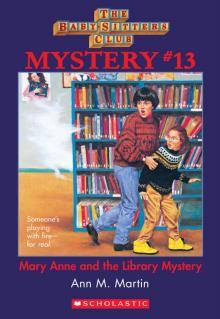 Mary Anne and the Library Mystery
Mary Anne and the Library Mystery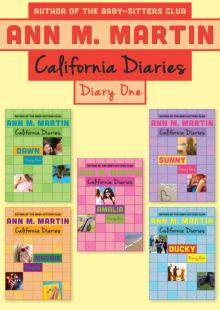 Diary One: Dawn, Sunny, Maggie, Amalia, and Ducky
Diary One: Dawn, Sunny, Maggie, Amalia, and Ducky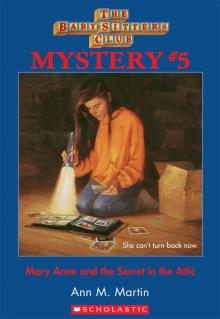 Mary Anne and the Secret in the Attic
Mary Anne and the Secret in the Attic Kristy and the Mother's Day Surprise
Kristy and the Mother's Day Surprise Karen's in Love
Karen's in Love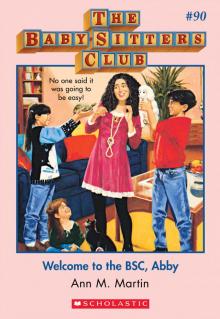 Welcome to the BSC, Abby
Welcome to the BSC, Abby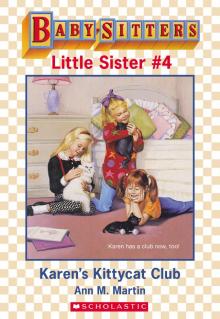 Karen's Kittycat Club
Karen's Kittycat Club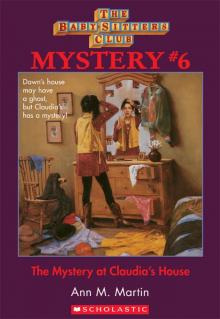 The Mystery at Claudia's House
The Mystery at Claudia's House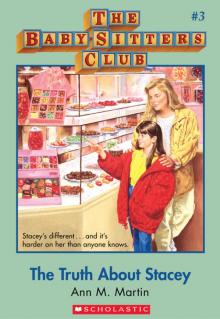 The Truth About Stacey
The Truth About Stacey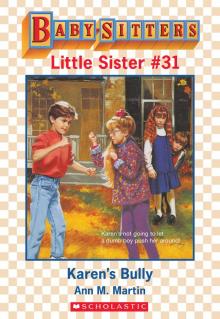 Karen's Bully
Karen's Bully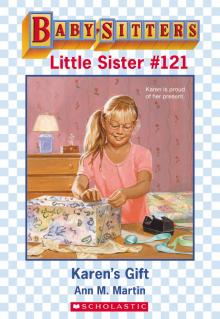 Karen's Gift
Karen's Gift BSC in the USA
BSC in the USA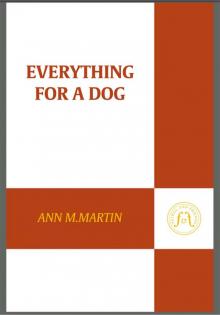 Everything for a Dog
Everything for a Dog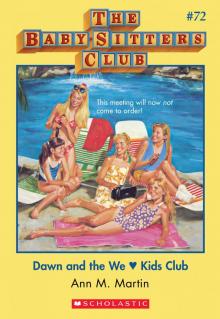 Dawn and the We Love Kids Club
Dawn and the We Love Kids Club Karen's Ghost
Karen's Ghost Stacey's Lie
Stacey's Lie Jessi's Secret Language
Jessi's Secret Language Kristy and the Missing Child
Kristy and the Missing Child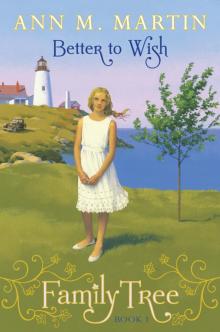 Better to Wish
Better to Wish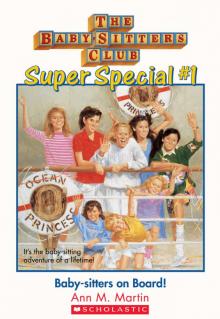 Baby-Sitters on Board!
Baby-Sitters on Board!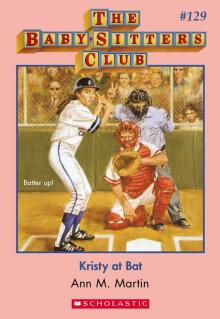 Kristy at Bat
Kristy at Bat Everything Changes
Everything Changes Don't Give Up, Mallory
Don't Give Up, Mallory A Dog's Life: The Autobiography of a Stray
A Dog's Life: The Autobiography of a Stray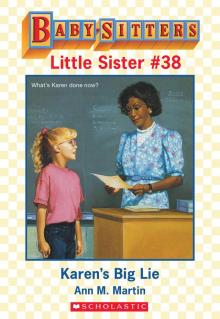 Karen's Big Lie
Karen's Big Lie Karen's Show and Share
Karen's Show and Share Mallory Hates Boys (and Gym)
Mallory Hates Boys (and Gym)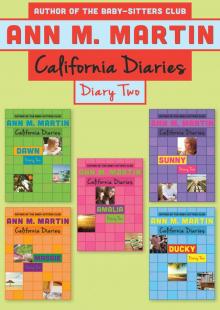 Diary Two: Dawn, Sunny, Maggie, Amalia, and Ducky
Diary Two: Dawn, Sunny, Maggie, Amalia, and Ducky Karen's Pen Pal
Karen's Pen Pal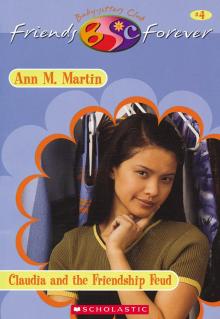 Claudia and the Friendship Feud
Claudia and the Friendship Feud Karen's Secret Valentine
Karen's Secret Valentine Keep Out, Claudia!
Keep Out, Claudia! Aloha, Baby-Sitters!
Aloha, Baby-Sitters!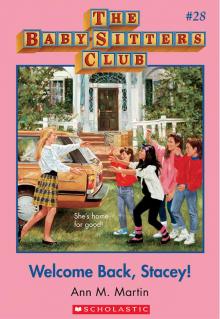 Welcome Back, Stacey
Welcome Back, Stacey Jessi Ramsey, Pet-Sitter
Jessi Ramsey, Pet-Sitter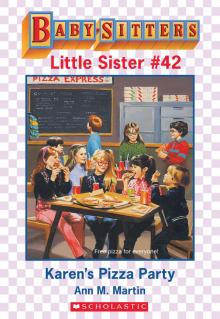 Karen's Pizza Party
Karen's Pizza Party Kristy and the Dirty Diapers
Kristy and the Dirty Diapers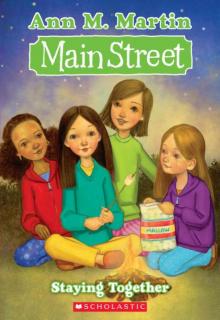 Staying Together
Staying Together Dawn and the Surfer Ghost
Dawn and the Surfer Ghost Claudia Makes Up Her Mind
Claudia Makes Up Her Mind Jessi's Gold Medal
Jessi's Gold Medal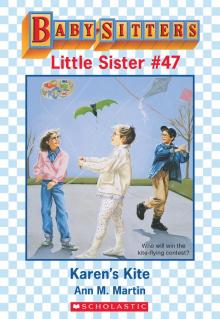 Karen's Kite
Karen's Kite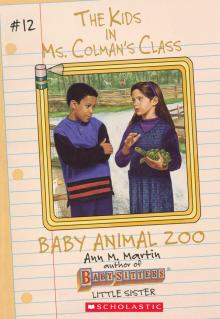 Baby Animal Zoo
Baby Animal Zoo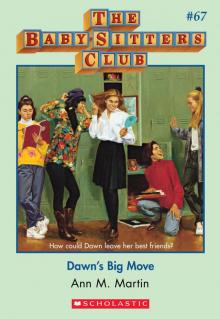 Dawn's Big Move
Dawn's Big Move Karen's Big Joke
Karen's Big Joke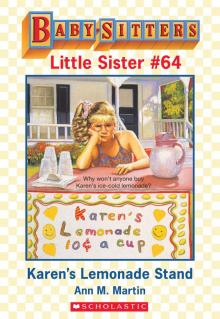 Karen's Lemonade Stand
Karen's Lemonade Stand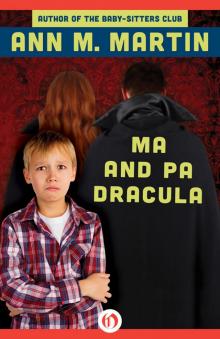 Ma and Pa Dracula
Ma and Pa Dracula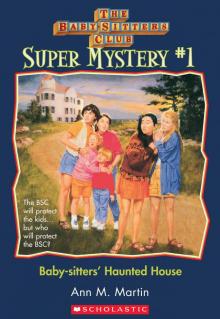 Baby-Sitters' Haunted House
Baby-Sitters' Haunted House Abby and the Mystery Baby
Abby and the Mystery Baby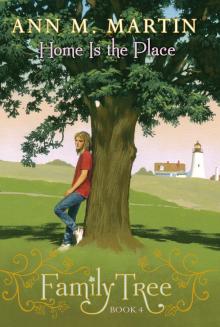 Home Is the Place
Home Is the Place Karen's Grandad
Karen's Grandad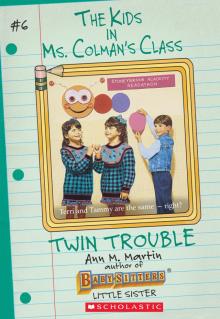 Twin Trouble
Twin Trouble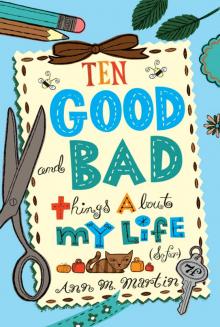 Ten Good and Bad Things About My Life (So Far)
Ten Good and Bad Things About My Life (So Far)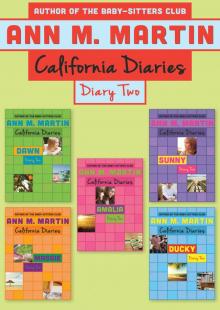 Diary Two
Diary Two Baby-Sitters Club 027
Baby-Sitters Club 027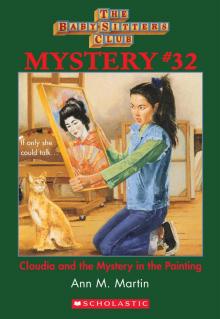 Claudia and the Mystery Painting
Claudia and the Mystery Painting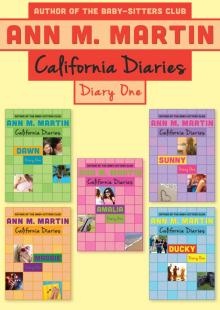 Diary One
Diary One Baby-Sitters Club 037
Baby-Sitters Club 037 Baby-Sitters Club 028
Baby-Sitters Club 028 Baby-Sitters Club 085
Baby-Sitters Club 085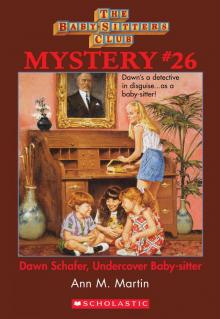 Dawn Schaffer Undercover Baby-Sitter
Dawn Schaffer Undercover Baby-Sitter Jessi's Babysitter
Jessi's Babysitter The Baby-Sitters Club #110: Abby the Bad Sport (Baby-Sitters Club, The)
The Baby-Sitters Club #110: Abby the Bad Sport (Baby-Sitters Club, The) Karen's Little Sister
Karen's Little Sister Baby-Sitters Club 058
Baby-Sitters Club 058 Claudia And The Genius On Elm St.
Claudia And The Genius On Elm St. Missy Piggle-Wiggle and the Sticky-Fingers Cure
Missy Piggle-Wiggle and the Sticky-Fingers Cure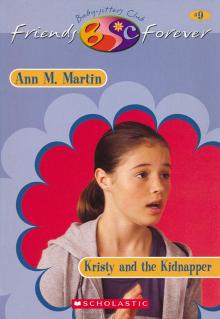 Kristy and Kidnapper
Kristy and Kidnapper Baby-Sitters Club 041
Baby-Sitters Club 041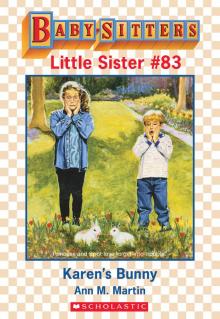 Karen's Bunny Trouble
Karen's Bunny Trouble Baby-Sitters Club 032
Baby-Sitters Club 032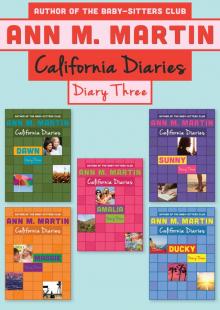 Diary Three
Diary Three Christmas Chiller
Christmas Chiller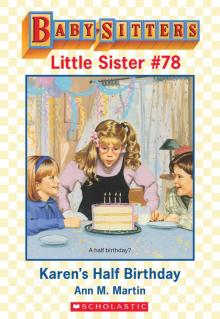 Karen's Half-Birthday
Karen's Half-Birthday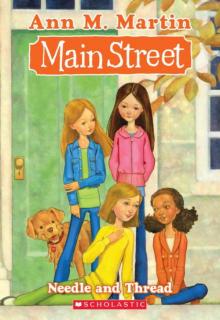 Needle and Thread
Needle and Thread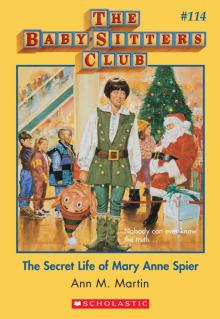 Secret Life of Mary Anne Spier
Secret Life of Mary Anne Spier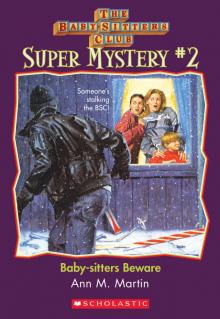 Baby-Sitters Beware
Baby-Sitters Beware Claudia Kishi, Middle School Drop-Out
Claudia Kishi, Middle School Drop-Out Logan Likes Mary Anne !
Logan Likes Mary Anne ! Baby-Sitters Club 061
Baby-Sitters Club 061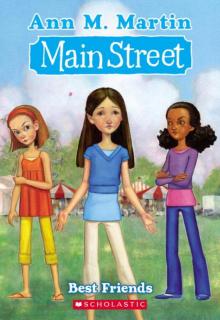 Best Friends
Best Friends Baby-Sitters Club 031
Baby-Sitters Club 031 Karen's Little Witch
Karen's Little Witch Jessi Ramsey, Petsitter
Jessi Ramsey, Petsitter Baby-Sitters Club 123
Baby-Sitters Club 123 Baby-Sitters Club 059
Baby-Sitters Club 059 Baby-Sitters Club 033
Baby-Sitters Club 033 Baby-Sitters Club 060
Baby-Sitters Club 060 Baby-Sitters Club 094
Baby-Sitters Club 094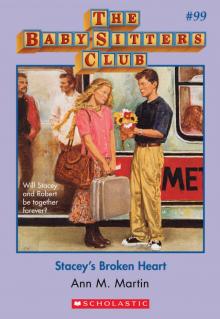 The Baby-Sitters Club #99: Stacey's Broken Heart
The Baby-Sitters Club #99: Stacey's Broken Heart The Baby-Sitters Club #109: Mary Anne to the Rescue (Baby-Sitters Club, The)
The Baby-Sitters Club #109: Mary Anne to the Rescue (Baby-Sitters Club, The) Mystery At Claudia's House
Mystery At Claudia's House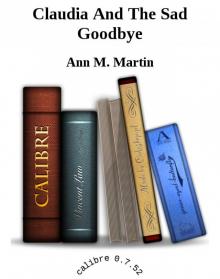 Claudia And The Sad Goodbye
Claudia And The Sad Goodbye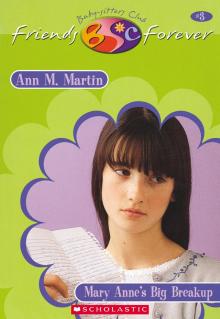 Mary Anne's Big Break-Up
Mary Anne's Big Break-Up Baby-Sitters Club 025
Baby-Sitters Club 025 Baby-Sitters Club 042
Baby-Sitters Club 042 Stacey and the Mystery of the Empty House
Stacey and the Mystery of the Empty House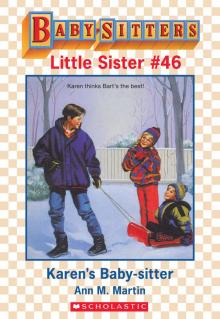 Karen's Baby-Sitter
Karen's Baby-Sitter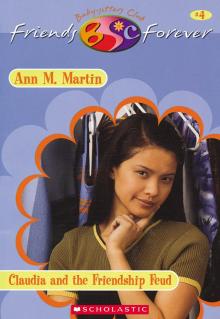 Claudia's Friendship Feud
Claudia's Friendship Feud Baby-Sitters Club 090
Baby-Sitters Club 090 Baby-Sitters Club 021
Baby-Sitters Club 021 Baby-Sitters Club 056
Baby-Sitters Club 056 Baby-Sitters Club 040
Baby-Sitters Club 040 The Baby-Sitters Club #108: Don't Give Up, Mallory (Baby-Sitters Club, The)
The Baby-Sitters Club #108: Don't Give Up, Mallory (Baby-Sitters Club, The) Dawn and the Impossible Three
Dawn and the Impossible Three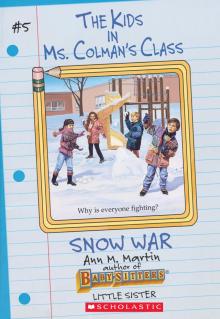 The Snow War
The Snow War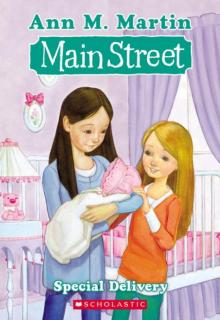 Special Delivery
Special Delivery Baby-Sitters Club 057
Baby-Sitters Club 057 Mary Anne And Too Many Babies
Mary Anne And Too Many Babies Baby-Sitters Club 030
Baby-Sitters Club 030